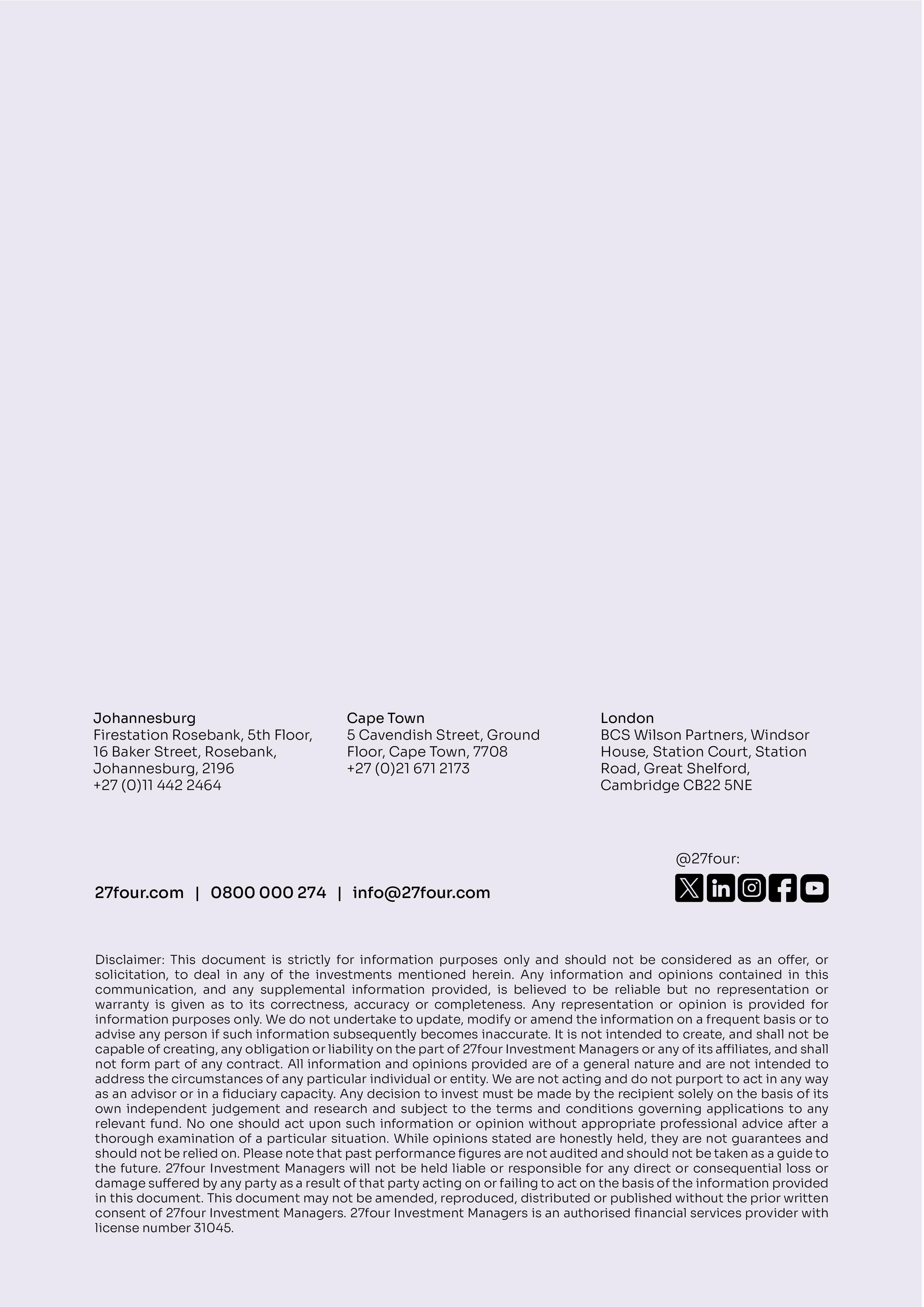Fund First, Fix Later: The Pitfalls of Policy by Aspiration
A Critical Review of the dtic’s March 2025 Draft Transformation Fund Concept Document




A Critical Review of the dtic’s March 2025 Draft Transformation Fund Concept Document



In March 2025, the Department of Trade, Industry and Competition (dtic) released the Draft Transformation Fund ConceptDocument. TheproposedTransformationFundaims to establish a R100 billion aggregated vehicle to address the persistent funding gap for businesses owned and managed by Black entrepreneurs, thereby enabling inclusive economic growth across key sectors of South Africa’s economy (dtic, 2025, p.3).
TheFundisaresponsetotheenduringbarriersfacedbyBlackowned enterprises, particularly limited access to affordable finance, non-financial support, and post-investment assistance. Against this backdrop, the dtic has proposed to “refocus on the implementation and empowerment objectives of B-BBEE through the establishment of a Transformation Fund” (dtic, 2025, p.4).
The stated objectives of the Transformation Fund are to:
•Promote economic transformation in order to enable meaningful participation of Black people in the economy.
•Improve access to funding for majority Black-owned and controlled enterprises.
•Empower and support majority Black-owned and controlled enterprises participation in value chains across key sectors of the economy.
• Mobilise financial resources from the private and public sector using broad-based Black economic empowerment (B-BBEE) legislation.
The Minister of Trade, Industry and Competition has invited public and stakeholder submissions on the draft document, with comments due by 28 May 2025.
This review is structured in alignment with the Fund’s core priority areas, namely:
Accelerating economic transformation by enhancing compliance with B-BBEE legislation; 1
Improve the efficacy of ESD in supporting SMMEs; and 2
Increase access to funding and technical support for majority Black-owned enterprises and SMMEs. 3
The draft concept document for the Transformation Fund is anchored in B-BBEE policy and legislation. However, more than twenty years after the promulgation of the B-BBEEAct(No. 53 of 2003, including any subsequent amendments), questions remain about the effectiveness of this framework in driving meaningful economic transformation. A key challenge is the absence of counterfactual studies that explore the potential impact of a South African economy without BBBEE legislation—or that evaluate alternative policy interventions aimed at achieving equality, redress, and inclusive growth.

Existing studies assessing the performance of B-BBEE are largely limited to trend analyses, such as those produced by the B-BBEE Commission, sector transformation councils, and various private organisations. These studies generally show a steady increase in the number of enterprises complying with B-BBEE requirements. For instance, Dreyer et al. (2021) assessed the B-BBEE status of 379 companies listed on the Johannesburg Stock Exchange (JSE) between 2004 and 2015. The study highlights how firms optimise B-BBEE scores by focusing on socio-economic development, enterprise and supplier development, and preferential procurement—often through external contributions rather than internal transformation.
While such trends suggest improved compliance, the Sanlam Transformation Gauge Report (2023) indicates that the pace of transformation is unacceptably slow. The average firm achieved a Level 3 B-BBEE rating, with a mean score of 90.23% of the target across 14,542 enterprises. While companies largely met socio-economic development targets, they consistently underperformed on other scorecard elements. The B-BBEE Commission’s (2022a) national status report showed that only 20% of reporting enterprises held a Level 1 rating, while an equal percentage were noncompliant. Notably, Level 1 status does not necessarily reflect Black ownership, but rather compliance with scorecard thresholds such as 25% Black voting rights. The same report found that 42% of public entities and organs of state were noncompliant—compared to just 12% of JSE-listed companies.
The reasons for this slow pace of compliance are not well understood. While some commentators argue that B-BBEE has benefited a narrow elite and created economic inefficiencies (Joosub, 2024), others point to systemic resistance. The 2023 Sanlam Transformation Gauge Report includes perspectives from 88 SANAS-accredited B-BBEE rating agencies. When asked whether poor performance on B-BBEE is due to “resistance by corporate South Africa to seeing Black people in leadership” or to “a lack of skills,” 51% of rating agencies selected the former (Sanlam, 2023, p. 8). This suggests that racism may be a structural barrier to transformation. The 27four Investment Managers’ (2024)Diversity,Equityand Inclusionreport reinforces this by highlighting how cognitive biases in corporate decision-making may be addressed through increased diversity.
Trend analyses, while useful, do not provide granular data on whether B-BBEE is achieving broader developmental outcomes such as employment, growth, and sector diversification. Since 2009, the BEE. conomicsSurveyby 27four Investment Managers has tracked transformation in the asset management subsector. In 2009, only 14 managers met the 51% Black ownership threshold. By 2023, this number had grown to 68 firms collectively managing R2.2 trillion in assets, with the majority of investment teams being Black. However, none of these firms met the scorecard’s management control target—a critical indicator of meaningful transformation. Based on employment equity data, 27four estimates that “it will take 170 years to achieve racial parity in top management positions in the financial sector at current levels of economic growth” (27four Investment Managers, 2023, p. 13).
The data reviewed support B-BBEE Commissioner Tshediso Matona’s call for a legislative review: “It is now more than 20 years of B-BBEE law, and I believe that the Act is due for a comprehensive review and amendment, taking into account successes, challenges and lessons of the journey” (Sanlam, 2023, p. 30). Matona also notes that the absence of embedded monitoring and measurement mechanisms leaves B-BBEE vulnerable to anecdotal evaluations—both positive and negative—rather than evidencebased assessments.
The draft Transformation Fund Concept Document appears to accept B-BBEE as an effective tool and focuses instead on accelerating compliance. It does not question the adequacy of current incentives or penalties within the Act—such as making B-BBEE compliance a condition for public procurement, accessing grants, or obtaining licences—nor does it evaluate whether stronger sanctions may be needed.
Furthermore, the document does not analyse the interplay between scorecard elements (e.g., how skills development influences management control, or how supplier development enhances preferential procurement). It also overlooks Matona’s concern about the lack of comprehensive impact reviews and instead continues what Theobald (2025) refers to as “inputitis”—an overemphasis on inputs (e.g., funding levels) without specifying measurable outcomes or defining a monitoring and evaluation strategy.

Although the draft claims that the Transformation Fund will establish “comprehensive monitoring, evaluation and reporting mechanisms” (dtic, 2025, p. 9), it does not present a theory of change or clearly defined success indicators. This raises doubts about whether the Fund can deliver “clear insights into financial performance, job creation and transformation outcomes” (dtic, 2025, p. 9).
The draft document also makes several assumptions that warrant scrutiny. For instance, it proposes that “sector funding from government departments be allocated to the Fund as seed capital” (dtic, 2025, p.
10), assuming interdepartmental cooperation and budget flexibility that may not exist. It is similarly silent on how the Fund will address noncompliance by public entities or overcome structural resistance to transformation. Its emphasis on “unity and collective action towards transformation” (dtic, 2025, p. 8)presumes that current incentives are adequate - despite evidence to the contrary.
Moreover, the document fails to address potential market distortion risks—such as the crowding out of private capital. South Africa’s 2024 venture capital industry, comprising roughly 202 funds, raised R28.1 billion for startups and early-stage growth enterprises (SAVCA, 2025). The implications of introducing a large public fund into this space require further consideration.
In the absence of a robust theory of change, outcome-based indicators, and a critical appraisal of B-BBEE policy mechanisms, the Fund risks being perceived as a superficial imposition rather than a strategic instrument for redress, equity, and inclusive economic growth.
Enterprise and Supplier Development (ESD) is a critical lever for transformation under the B-BBEE legislation. The 2013 amendment to the B-BBEE Act (No. 53 of 2003) elevated ESD to one of three priority elements of the B-BBEE scorecard, introducing a sub-minimum compliance threshold of 40%. Measured entities are required to spend 2% of net profit after tax (NPAT) on supplier development and 1% on enterprise development.
It is estimated that enterprises collectively spend between R20 billion and R30 billion annually on ESD (Myres et al., 2024). In 2021 alone, R26 billion was spent—representing 46.6% of the target. While this is only half the set target, it is still “more than 10 times the R2.567 billion allocated to the Department of Small Business Development (DSBD) and its agencies by National Treasury for the 2023/24 financial year. Basic Education received R30.788 billion in the same period. This shows the relative scale of investment in ESD by measured entities” (Sanlam, 2023, p. 27).
However, as discussed earlier, there are no impact evaluations of the B-BBEE interventions, including ESD. Myres et al. (2024) attempted to assess the effectiveness of ESD by interviewing 41 stakeholders including corporate ESD programme leads, Business Development Support Practitioners (BDSPs), and beneficiaries. Their findings highlight that effective ESD programmes tend to be integrated into company strategy, monitored consistently, grounded in a valid theory of change, and provide tailored, one-on-one support to SMMEs to help them meet corporate standards.
At the same time, Myres et al. (2024, p. 17) offer a strong critique of the largely unregulated ESD ecosystem, describing it as “corrupt and intensely competitive.” The large sums involved in ESD have, in some instances, created space for corrupt practices between BDSPs and corporate procurement staff. Some BDSPs even expect equity stakes in successful SMMEs after brokering contracts with measured entities. With approximately 4,500 BDSPs operating in this space, the authors recommend selfregulation and the formation of a professional community of practice grounded in ethical standards. The DSBD has introduced new legislation to address this (see next section).
The B-BBEE Commission’s (2022b) own study similarly finds that ESD funds are more effective when backed by strategy, budget, and non-financial support. However, many entities favour straightforward compliance through monetary contributions—such as grants and early payments—over developmental interventions like mentoring. Only a third of enterprises in the study offered mentoring programmes. The Commission recommends that ESD strategies should be long-term, senior management-driven, and based on sound theories of change.

Notably, the vast majority of enterprises (73%) preferred to manage ESD implementation internally, rather than outsourcing it or contributing to pooled structures. This suggests reluctance to transfer ESD funds to an aggregated fund unless compelling incentives are provided. Public entities and organs of state perform poorly on ESD implementation, often because it falls outside their defined mandates and key performance indicators (B-BBEE Commission, 2022b).
In response to these challenges, the B-BBEE Commissioner has proposed the establishment of a centralised fund with a governance model akin to the Solidarity Fund, which was created during the COVID-19 pandemic. The Commissioner further recommends the creation of a vetted register of Black-owned enterprises to improve the targeting and impact of ESD interventions (B-BBEE Commission, 2022b, p. 9). The draft Transformation Fund Concept Document echoes this sentiment, stating that “the ESD contributions do not seem to have the anticipated impact on marginalised groups” (dtic, 2025, p. 6). The document argues that a centralised Transformation Fund would more efficiently allocate ESD funds, provide technical assistance, and facilitate market access for SMMEs.
Yet, while the draft document highlights the importance of market access—stating that “one of the most significant advantages for SMMEs participating in ESD initiatives is access to market opportunities” (dtic, 2025, p. 22)—it offers little detail on how the Fund will facilitate such access or provide the mentoring support necessary to help SMMEs meet corporate quality standards.
It is difficult to envisage how a centralised fund could develop the sector-specific expertise required to mentor and integrate beneficiary SMMEs into complex supply chains across the economy. In contrast, well-established ESD programmes managed by corporates often possess the internal capacity and sectoral knowledge to provide meaningful support to SMMEs. These programmes are also well-positioned to transform supply chains in sustainable ways.
A key weakness in theDraftTransformationFundConceptDocumentis its failure to explain how the proposed aggregated fund will serve South Africa’s large, diverse, and unevenly developed SMME sector. A fundamental question is whether the Fund will have physical infrastructure and human capacity in provinces with the least developed SMME ecosystems—such as Limpopo (3.8%), Free State (2.4%), Mpumalanga (2.3%), North West (1.8%) and Northern Cape (1.1%)—which collectively account for 7.6% of all SMMEs (Shoprite, 2025). It is unclear what portion of the Fund’s budget will be allocated to resourcing and maintaining this infrastructure.
According to FinScope (2024), South Africa is home to approximately 3 million SMME owners employing over 13 million people across full-time, part-time and seasonal roles, contributing an estimated R5.29 trillion in turnover. Of this, formal businesses contribute R3 trillion, township economies R2.4 trillion, and rural economies R256 billion. SMMEs operate largely in the services, trade, manufacturing, and agriculture sectors and engage primarily with private consumers (82%), other SMMEs (57%), large businesses (34%), and government (26%).
The draft document prioritises “productive sectors” such as agriculture, mining, manufacturing, infrastructure, services, technology, and green industries. However, these sectors already have significant SMMEparticipation.Thisapproachmayunintentionallyexacerbate uneven transformation across sectors and neglect the demographic transformation of SMME ownership. Youth ownership remains low at 6.8%, while women own 51.3% of micro-enterprises (1–5 employees) but only 12.5% of medium-sized enterprises (51–200 employees) (Shoprite, 2025).
Extensive research highlights the challenges SMMEs face: limited access to finance and markets, burdensome regulation, high crime rates, equipment shortages, staff theft, and weak technical capabilities (Davidson et al., 2024; FinScope, 2024; GEM, 2024; Myres et al., 2024; Shoprite, 2024; SME South Africa, 2018; Xero, 2024). SME South Africa (2018) found that 85% of SMMEs require support with market access. In 2024, political and economic instability, crime, loadshedding, weak government support,limiteddemand,fundingconstraints,skillsshortages,andlatepaymentsarepressingconcerns (Xero, 2024). Importantly, FinScope (2024, p. 42) warns that “the requirements of the support funds and support programmes do not match the existing reality (of the majority of informal businesses).”
The draft document states that “the Fund will facilitate pre- and post-investment support, including, among others, business planning, feasibility and environmental impact studies” (dtic, 2025, p.7). However, it fails to explain how such support will be operationalised. To be effective, the Fund would require a large, sectorally-knowledgeable business development workforce—yet the document is silent on staffing, structure, capabilities, and associated costs.

Should the Fund opt to outsource technical assistance to Business Development Support Practitioners (BDSPs)—as many enterprises currently do (B-BBEE Commission, 2022b)—it would need the capacity to manage thousands of contracts. Without proper oversight, the Fund may replicate the shortcomings it attributes to ESD programmes, including inconsistent quality and corruption. As highlighted earlier, the BDSP ecosystem lacks regulation and ethical standards.
In October 2024, the DSBD operationalised the Small Enterprise Development Finance Agency (SEDFA) under the National Small Enterprise Amendment Act 21 of 2024. SEDFA consolidates several agencies and aims to strengthen the SMME ecosystem and professionalise the BDSP sector. The draft Transformation Fund document does not clarify how it will coordinate with or support SEDFA, creating the impression of competition rather than alignment.
Government support for SMMEs extends across various programmes, including the Agro-processing Support Scheme, Black Industrialist Scheme, National Youth Development Agency initiatives, Growth Fund, and National Empowerment Fund. The private sector also contributes through mechanisms like the SA
SME Fund and capital mobilisation in the venture capital and private equity markets. While the draft document acknowledges the diversity of the ESD market, it does not articulate how the Transformation Fund will integrate within or add value to this broader ecosystem.
The 2024 Xero survey of SMMEs observes that 87% of respondents do not believe government support to be sufficient. In 2018, only 6%1 of SMMEs received funding from government (SME South Africa, 2018). FinScope data from 2024 shows that just 4% of SMME startup capital comes from government grants. While SMMEs are aware of government programmes, they often rely instead on personal savings, salaries, and social capital—such as contributions from family, friends, and community networks. This suggests that either the funding is insufficient or that many SMMEs do not meet eligibility criteria. The draft document does not address how it will overcome these barriers or perceptions.
Perceptions of South Africans lacking entrepreneurial spirit are also contested. According to the Global Entrepreneurship Monitor (GEM, 2023), South Africa ranked third-lowest out of 49 countries on the National Entrepreneurial Context Index, with steep declines in 11 of 13 indicators. The lowest score was for social and cultural norms that encourage entrepreneurship. However, GEM also found that 60% of South Africans believe they have the knowledge and ability to start a business, although many are deterred by fear of failure. Most new entrepreneurs are necessity-driven, launching businesses due to a lack of job opportunities rather than to pursue wealth.
Local experts reject the idea that South Africans lack entrepreneurial spirit, citing high business formation rates—although around 40% of startups close within six months (CDE, 2021). Key structural barriers to success include unfair practices by large corporations, limited legal recourse, and restricted market access. The National Small Enterprise Amendment Act 21 of 2024 addresses legal recourse through the establishment of the Office of the Small Enterprise Ombud Service, while effective ESD programmes can enable market access.
1 These few SMMEs obtained funds from government grants (21%), the dtic (17%), national youth development agency (16%), small enterprise development agency (15%), Gauteng enterprise propeller (15%), other (13%), small enterprise finance agency (2%) and national empowerment fund (1%). Similarly, 9% reported that they received non-governmental funding. Half of these respondents (50%) were self-funded or accessed funds from family and other private sources, 24% from business incubators, 10% from other, 9% from venture capital, 8% from debt financing, 7% from SA SME Fund and 6% from seed funding (SME, 2018).

The Draft Transformation Fund Concept Document (March 2025) presents the Fund as a potential panacea for the wide-ranging challenges faced by majority Black-owned businesses and SMMEs. However, it falls short in detailing how this aggregated “super fund” will practically deliver on such ambitions. In the absence of clearly defined mechanisms and implementation strategies, the Fund risks being perceived as yet another vehicle for elites to access public and private resources—particularly in light of its intention to allocate a portion of funding specifically to entities classified as “Black Industrialists” under theBlackIndustrialistPolicy(dtic, 2025, p.13).
27four propose the following recommendations for strengthening the Draft Transformation Fund ConceptDocument (March 2025):
1
2
Develop a Theory of Change: Clearly articulate how the Transformation Fund will drive economic transformation, identifying the mechanisms through which it will enhance funding and support for majority Black-owned enterprises and SMMEs.
Define Measurable Outcomes: Establish specific, measurable outcomes for the Fund and accompany these with a robust monitoring, evaluation, research, and learning (MERL) framework.
3
4
Clarify Ecosystem Integration: Demonstrate how the Transformation Fund will complement and strengthen the existing SMME support ecosystem and attract additional investment and resources into the sector.
Strengthen the BDSP Ecosystem: Detail how the Fund will contribute to the development of a professional, ethical community of practice among Business Development Support Practitioners (BDSPs).
5
Align with ESG Objectives: Articulate the alignment between the objectives of the Transformation Fund, B-BBEE legislation, and broader environmental, social, and governance (ESG) goals.
1. 27four Investment Managers. (2023). BEE.conomics Transformation in the South African Asset Management, Johannesburg, www.27four.com/ wp-content/uploads/2023/09/BEEconomics-2023-annual-transformation-in-SA-asset-management-survey.pdf.
2. 27four Investment Managers. (2024). DEInvest Annual Survey 2024, Johannesburg.
3. Broad-Based Black Economic Empowerment Commission. (2020). National Status and Trends on Broad-Based Black Economic Empowerment, Pretoria, https://www.bbbeecommission.co.za/wp-content/uploads/2020/07/National-Status-and-Trends-on-Broad-Based-BlackEconomic-Empowerment_.pdf.
4. Broad-Based Black Economic Empowerment Commission. (2022a). National Status and Trends on Broad-Based Black Economic Empowerment, Pretoria, www.bbbeecommission.co.za/wp-content/uploads/2024/04/2022-NATIONAL-STATUS-REPORT.pdf.
5. Broad-Based Black Economic Empowerment Commission. (2022b). Determining, the effective implementation of enterprise and supplier development funds, www.bbbeecommission.co.za/wp-content/uploads/2022/11/Determining-the-Effective-Implemetation-of-Enterpriseand-Supplier-Developmemt-Funds-Report_compressed.pdf.
6. Centre for Development and Enterprise (2021). What role can small and micro businesses play in achieving inclusive growth: Question requiring answers, Johannesburg, https://cde.org.za/wp-content/uploads/2022/08/Small-Business-report-2021.pdf.
7. Corruption Watch. (2024). The impact of corruption: Insights from a perceptions and experiences survey, Johannesburg, https://www. corruptionwatch.org.za/wp-content/uploads/2024/05/Corruption-Watch-Report-Experiences-and-Perceptions_FINAL-1.pdf.
8. Davidson, A., Kim, S., & Almaguer. (2024). State of the small and growing business sector in South Africa, Aspen Network of Development Entrepreneurs, https://andeglobal.org/wp-content/uploads/2024/02/State-of-the-Small-and-Growing-Business-Sector-in-South-Africa_ Feb-2024.pdf.
9. Department of Trade and Industry. (2013). Broad-Based Black Economic Empowerment Act (53/2003): Issue of Codes of Good Practice, Government Gazette, 528, Number 36928, 11th October 2013, Cape Town, www.thedtic.gov.za/wp-content/uploads/BEE-code_gud_ practice10102013.pdf.
10. Department of Trade and Industry. (2019). Codes of Good Practice on Broad Based Black Economic Empowerment, Government Gazette, Number 42496, 31st May 2019, Cape Town.
11. Department of Trade , Industry and Competition. (2025). Draft Transformation Fund Concept Document, March 2025, Pretoria, www.thedtic. gov.za/wp-content/uploads/Draft-Transformation-Fund-Concept-Document.pdf.
12. Dreyer, J., Viviers, S., & Mans-Kemp, N. (2021). Reflecting on compliance with Broad-Based Black Economic Empowerment codes of good practice: Trends and suggestions. South African Journal of Business Management, 52(1), 11 pages. doi: https://doi.org/10.4102/sajbm.v52i1.1963.
13. Financial Sector Transformation Council. (2021). 2020/21 State of Transformation Annual Report, Johannesburg, https://fstc.org.za/assets/ documents/state-of-transformation/2020-21_State_of_Transformation_Annual_Report.pdf.
14. FinScope. (2024). FinScope MSME Survey South Africa 2024, https://finmark.org.za/Publications/FS_MSME_2024_results_launch.pdf.
15. Global Entrepreneurship Monitor. (2024). GEM 2023/24 Global Report: 25 years and growing, https://www.gemconsortium.org/report/globalentrepreneurship-monitor-gem-20232024-global-report-25-years-and-growing.
16. Joosub, I. (2023). From empowerment to elitism: The BBBEE dilemma and constitutional tensions, 2nd September 2024, Mail & Guardian, https:// mg.co.za/thought-leader/2024-09-02-from-empowerment-to-elitism-the-bbbee-dilemma-and-constitutional-tensions/#:~:text=In%20 contrast%2C%20BBBEE’s%20rigid%20quotas,unemployment%20and%20reduced%20state%20efficiency.
17. Myres, K., Cabot-Alletzhauser, A., Khosa, A., & Mamabolo, A. (2024). Enhancing enterprise and supplier development ecosystem effectiveness in South Africa – White Paper, Gordon Institute of Business Science, University of Pretoria, https://content.gibs.co.za/cmscontent/media/ noqd4y5f/myres_enhancing-enterprise-and-supplier-development-ecosystem-effectiveness-in-south-africa-change_2024.pdf.
18. Patel. S. (2016). Broad-Based Black Economic Empowerment, Weber Wentzel, www.webberwentzel.com/About-us/How-we-make-adifference/Investing-in-South-Africa/Documents/CHAPTER%2017%20-%20BROAD-BASED%20BLACK%20ECONOMIC%20EMPOWERMENT. pdf.
19. Republic of South Africa. (2003). Broad-based Black economic empowerment act, number 53, Government Gazette, 463 (25899), Cape Town.
20. Republic of South Africa. (2024). National small enterprises amendment act number 21 of 2024, Government Gazette, 709 (50965), Cape Town, https://www.gov.za/sites/default/files/gcis_document/202407/50965nationalsmallenterpriseamendmentact212024.pdf.
21. Republic of South Africa. (996). Constitution of the Republic of South Africa, number 108, Government Gazette, 378 (17678), Cape Town.
22. Sanlam. (2023). Transformation Gauge Report 18 July 2024, https://www.sanlam.com/pdf/transformation/2023/sanlam-gauge-campaigndigital-report.pdf.
23. Shoprite. (2025). The state of the SMME in South Africa, Cape Town, https://www.shopriteholdings.co.za/docs/shp-smme-report-2025.pdf.
24. SME South Africa. (2018). An assessment of South Africa’s SME landscape: Challenges , opportunities, risks & next steps, https://www. smallbusinessinstitute.co.za/wp-content/uploads/2019/12/AssessmentOfSAsSMELandscape.pdf.
25. South African National Accreditation System. (2024). Annual Report 2023/24, Pretoria, www.sanas.co.za/Brochures%20and%20Reports/ Annual%20Report%20for%202023%20-%202024.pdf.
26. Southern African Venture Capital and Private Equity Association. (2025). Private Capital Magazine, Johannesburg, https://savca.co.za/wpcontent/uploads/2025/03/PE-Private-Capital-Mag-2025-Web.pdf.
27. Theobald, S. (2025). Transformation Fund simply worsens disease of ‘inputitis’, Business Day, 26 March 2025, https://www.businesslive.co.za/ bd/opinion/columnists/2025-03-26-stuart-theobald-transformation-fund-worsens-disease-of-inputitis/.
28. Xerox. (2024). State of South African Small Business 2024, https://brandfolder.xero.com/8HSCTPAX/as/nth3s554vckqv832g8n4jbf/Xero_ State_of_Small_Business_2024_Digital_Pages.

